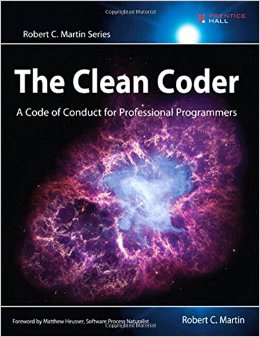The Clean Coder, Chapters 1 & 2
After reading the first 2 chapters I felt like I had read my
own experiences over the past twenty something years. I wasn’t a programmer or
in anything to do with computers, but the more I read and learn about this field
the more I find that even though I was doing something different, a lot of the same
issues happen no matter where you are.
In the first chapter on professionalism he talks about how
it is easier to be a nonprofessional because they don’t have to take
responsibility for the job they do. That got me to thinking about the term. No
matter what job or jobs I have had I always tried to do them as a professional.
I think the term work ethic could be used to describe professionalism as well.
You get out what you put in. I felt like I had been in similar situations as I
read the chapter. He seemed to go through something everyone must go through at
some point in life. I enjoyed how he learned from his errors and passed wisdom
on. The lessons learned from releasing the product without properly testing and
it went south. This was all to save face and look good because it went out on time,
but then the backfire. Though you think you are saving time, in the end you
lose time and man hours when if it had of been done right the first time a lot
could be prevented.
I like his take on the do no harm function as well. We can’t
be perfect, but we must be responsible for our imperfections and should always
be trying to get our error rate approaching zero and expect QA to find nothing
wrong. If that is the thought process you should genuinely be surprised when
they do find a flaw. I have been in the situation where I half assed something
to get it done on time and was not surprised in the least when it failed.
Wasted time and hours when I should have just done it right the first time.
I really felt like his work ethic and knowing your field hit
the nail on the head as well. They gave me something to try and think about. I
like the time breakdown. It humbled me actually when he was talking about the
first 40 are for the employer and 20 aside for me. I had never thought of it
that way and it humbled me. He set up some very realistic ideas on how to
utilize time. As far as knowing the field, I feel like I have a lot to do. I
know I am just getting started, but I didn’t realize just how much there is to
just know for the basics. I picked up a copy of the gang of four design
patterns books to increase my learning on that end and plan on just plucking
away each day to increase my chops.
Overall I gained a great deal from chapter one and plan on
reading it again. I wish I had come across this sooner.
Chapter 2 and saying no brought back many memories as well.
I think a lot of people in general have issues with saying no and want to just
get along and cause no waves. I am one of those, well was. I do not like to say
no because it is uncomfortable for sure, but that was because of the way that I
said no. I usually offended someone because I didn’t think before I spoke. I
have changed. He makes some great points on how to and not to approach
situations. His role playing scenarios were ones I have been a part of myself
to some degree. I was one of those people that used to say I’ll try and had
never thought boss would think of that as a yes I can get it done on time. It
makes sense though because I’ll try is like beating around the bush. Overall there were a lot of good points that
can be used no matter where or what job you are doing. I am sure that once I
get into the field that I will be practicing my version of saying no and this
book will come to mind.
Week 1 learning
I am still trying to process everything that I have gone
over this week and am still in the process of going over it. The first couple
weeks of the semester are the hardest for me. I try to make a schedule of my
time so I can manage everything. I am excited for this one though as it is my
last undergrad semester and a long time coming. I have been going through some
Angular 2 tutorials to get a grasp on how it works, and using the node package
manager and other tools. I think it is going to be a lot of fun to learn and
use and I hope to become proficient with it.
The Open MRS project is overwhelming to me so far, but that
is I guess because I am just getting into what it is all about. I tried the
demo and like the functionality and can’t wait to get my hands dirty. I think
it is great that so many folks are collaborating on this records system that
can help so many people around the globe. I am eager to get started in this
journey and hope that whatever we do this semester has an impact in the years
to come. I know I am going to have a lot of challenges, but I welcome them with
open arms.
From the blog format c: /s by c-braley and used with permission of the author. All other rights reserved by the author.

